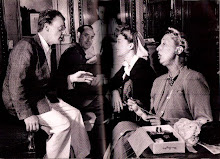_01.jpg) I just watched the 1955 James Cagney/Henry Fonda/Jack Lemmon/William Powell movie Mister Roberts for the first time, and it was cool. James Cagney didn't really have a lot of screentime in this film, but he convincingly portrayed the tyrannical Captain as the ship dictator he was through his wonderful acting. Another appeal of this movie that took place during WWII was that it had an all-star cast and directed by famous director John Ford (well, it was mostly directed by Mervyn LeRoy; it had two directors).
I just watched the 1955 James Cagney/Henry Fonda/Jack Lemmon/William Powell movie Mister Roberts for the first time, and it was cool. James Cagney didn't really have a lot of screentime in this film, but he convincingly portrayed the tyrannical Captain as the ship dictator he was through his wonderful acting. Another appeal of this movie that took place during WWII was that it had an all-star cast and directed by famous director John Ford (well, it was mostly directed by Mervyn LeRoy; it had two directors). The film takes place on an American Naval cargo ship during the waning days of World War II. The ship's perpetual mission is to supply the United States fleet in the South Pacific. The ship’s captain, Morton, has a spotless record of cargo delivery that he maintains through an oppressive command: he refuses to let the crew remove their shirts during hot days working in the cargo hold and has not granted his men ”liberty” for at least two years, despite frequent requests from his XO, Lt. JG Douglas "Mister" Roberts, who serves as cargo chief. Roberts has an excellent working relationship with the crew, often bending the rules to allow them some leeway. Morton’s reputation for timely handling of cargo was rewarded with a palm tree from an impressed admiral, which he keeps in a dirt-filled bucket near the ship’s bridge; Morton is quite proud of his gift, however, the crew despises the tree and the Captain himself.
The film takes place on an American Naval cargo ship during the waning days of World War II. The ship's perpetual mission is to supply the United States fleet in the South Pacific. The ship’s captain, Morton, has a spotless record of cargo delivery that he maintains through an oppressive command: he refuses to let the crew remove their shirts during hot days working in the cargo hold and has not granted his men ”liberty” for at least two years, despite frequent requests from his XO, Lt. JG Douglas "Mister" Roberts, who serves as cargo chief. Roberts has an excellent working relationship with the crew, often bending the rules to allow them some leeway. Morton’s reputation for timely handling of cargo was rewarded with a palm tree from an impressed admiral, which he keeps in a dirt-filled bucket near the ship’s bridge; Morton is quite proud of his gift, however, the crew despises the tree and the Captain himself.
Mister Roberts (1955) started as a novel by Thomas Heggen, but became popular when it hit Broadway as a stage play in 1948, written by Heggen and Joshua Logan. The play starred movie actor Henry Fonda who had left Hollywood after making Fort Apache (1948) with director John Ford. For once, that turned out to be a wise decision, as the play became one of Broadway's most popular hits.
When Logan and the play's producer, Leland Hayward, went to Warner Brothers to make the film version, Fonda felt there was little chance he would be given Roberts. After all, he was then nearly fifty years old and Roberts was written as being a man in his twenties. In fact, Warner Brothers would have preferred Marlon Brando or William Holden in the lead. However, one of the first decisions the producing team made was bringing Ford onboard as director and Ford demanded Fonda. To make Fonda seem younger, most of the rest of the cast was populated with older actors; fifty-five year old James Cagney as the dictatorial Captain Morton and, after Spencer Tracy turned down the role, sixty-two year old William Powell for Doc. For the young Ensign Pulver, Ford chose a little-known actor who had made a screen test for his previous movie The Long Grey Line (1955)- Jack Lemmon. 
As the filming began, sailing could not have seemed smoother. Ford used his Navy connections to find one of the old cargo scows to use for the story's setting and boat; cast and crew were all sent to Midway Island for exterior shooting. Why it all went wrong is a matter of controversy. After years playing Roberts on stage, Fonda felt he owned the role and knew how it was to be played. Ford had other ideas, introducing bits of broad physical comedy, inventing new situations and, allegedly, throwing more attention to Lemmon's Pulver than Fonda's Roberts. Fonda kept his mouth shut but Ford could tell he was dissatisfied. One night, Ford confronted Fonda in his quarters while Fonda was having a meeting with Hayward. "I understand you're not happy with my work," Ford muttered and, when Fonda confirmed it, Ford charged him, swinging wildly. Fonda managed to hold him back and Ford later apologized. The damage, however, was done and was irreparable.
Ford continued directing the movie into the next month but could not handle being subservient to an actor. His way of dealing with the humiliation was drinking, keeping an ice chest full of beer nearby and downing up to two cases a day. After exterior shooting was completed, Ford was hospitalized with a gall bladder attack. The day he went into hospital for surgery, he was replaced by Mervyn LeRoy, the director of I Am a Fugitive from a Chain Gang (1932) and Quo Vadis? (1951). LeRoy shot all the studio-bound interiors except for two scenes, the laundry scene and Pulver's final message to the Captain, both of which were directed by Joshua Logan.
Those who knew the play well from Broadway were unhappy with the end result but their perspective may have been colored by unrealistic expectations. Movie audiences loved Mister Roberts, making it 1955's third-biggest box office hit, and earning Jack Lemmon his first Academy Award. Ford went on to what many feel was his greatest movie, The Searchers (1956), while Fonda had a long career of acting triumphs. But these two former friends never worked together again.
The movie was directed by John Ford, Mervyn LeRoy and Joshua Logan (uncredited). While directing the film, Ford had personality conflicts with actors Henry Fonda and James Cagney. When Ford met Cagney at the airport, the director warned that they would "tangle asses," which caught Cagney by surprise. Cagney later said: "I would have kicked his brains out. He was so goddamned mean to everybody. He was truly a nasty old man." The next day, Cagney was slightly late on set, and Ford became incensed. Cagney cut short the imminent tirade, saying "When I started this picture, you said that we would tangle asses before this was over. I'm ready now – are you?" Ford walked away and he and Cagney had no further conflicts on the set.
During the production of the film, Jack Lemmon started a long-time friendship with Cagney which lasted until Cagney's death in 1986. Their first introduction is as funny as the film itself. Prior to his appearance in his first film, years before Mister Roberts, he started in live television. In one particular performance, Jack Lemmon decided to play his character differently. In his brainstorming he decided to play the character left-handed, which is opposite to his own way of movement. With much practice, he pulled off the performance without anyone noticing the change. This change even fooled Lemmon's wife at the time. A few years went by and Jack met Cagney on their way to Midway Island to film Mister Roberts. They introduced each other and Cagney chimed in "Are you still fooling people into believing you're left handed?" They had a great laugh and a strong friendship endured ever since. As Lemmon noted, this was an example of James Cagney's ability to observe human behavior for his acting.
Henry Fonda wrote in his 1982 autobiography, My Life, that he believed that as good as the movie is, the play is even better. The film was William Powell's last movie, although he died decades later, in 1984. Powell was offered many chances to return to the screen but refused, apparently believing that 35 years of film acting were enough. Anyway, I would recommend this film for James Cagney fans who are also fans of Henry Fonda, Jack Lemmon, or William Powell. Happy Commenting!!! 
(Next blog [for sure]: Horse Feathers [1932])
Clips from Mister Roberts:
.jpg)










 I didn't really watch the shooting scenes because they were too dramatic. Anyway, this film is a must for any James Cagney fan, but I have a legitimate reason for such procrastination: I never really liked James Cagney's famous films, including Yankee Doodle Dandy. I really preferred films like Footlight Parade, Taxi!, Hard to Handle, some of his underrated works. I do not care for the famous ones, especially Angels with Dirty Faces. Happy Commenting!!!
I didn't really watch the shooting scenes because they were too dramatic. Anyway, this film is a must for any James Cagney fan, but I have a legitimate reason for such procrastination: I never really liked James Cagney's famous films, including Yankee Doodle Dandy. I really preferred films like Footlight Parade, Taxi!, Hard to Handle, some of his underrated works. I do not care for the famous ones, especially Angels with Dirty Faces. Happy Commenting!!! (Next blog [for sure]: Monkey
(Next blog [for sure]: Monkey




 "So Full of Spectacle and Glory it Had to be Made in Technicolor!" screamed the ads for Captains of the Clouds, and sure enough, James Cagney's first
"So Full of Spectacle and Glory it Had to be Made in Technicolor!" screamed the ads for Captains of the Clouds, and sure enough, James Cagney's first 
 Captains of the Clouds sprang from a magazine story called "Bush Pilots" which Canadian actor Raymond Massey had brought to Wallis's attention. Cagney wasn't crazy about the script but was persuaded to do the film by Jack Warner, who told him that he would be contribu
Captains of the Clouds sprang from a magazine story called "Bush Pilots" which Canadian actor Raymond Massey had brought to Wallis's attention. Cagney wasn't crazy about the script but was persuaded to do the film by Jack Warner, who told him that he would be contribu




 (Next blog: A Day a
(Next blog: A Day a






















